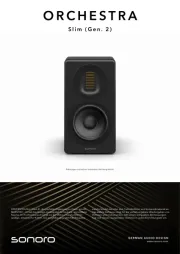Acoustic Research AWS6 Bedienungsanleitung
Lies die bedienungsanleitung für Acoustic Research AWS6 (4 Seiten) kostenlos online; sie gehört zur Kategorie Lautsprecher. Dieses Handbuch wurde von 4 Personen als hilfreich bewertet und erhielt im Schnitt 5.0 Sterne aus 2.5 Bewertungen. Hast du eine Frage zu Acoustic Research AWS6 oder möchtest du andere Nutzer dieses Produkts befragen? Stelle eine Frage
Seite 1/4

Wireless audio transmitter
Signal Power
DC IN
CHANNEL
1 2 3
R AUDIO L
IN
Power
L M R
DC
IN
Bass Boost
On / Off
Auto Scan
Volume +
Volume -
Introduction
AR’s Wireless Speaker System eliminates the hardest part of adding speakers to your home—
running and hiding hundreds of feet of speaker wire. The AR Wireless Speaker System’s RF
signal travels with ease through walls, fl oors, ceilings and other obstacles, delivering high-
quality sound virtually anywhere inside the house or out. With drift- and static-free reception
along with outstanding range—up to 150 feet*—the possibilities for enjoying your AR Wireless
Speaker System are nearly unlimited. The AR Wireless Speaker System is compatible with most
audio sources, such as A/V receivers/amps, stereos, computers, TVs, DVD players, and portable
devices (CD players, cassette players, MP3s etc.).
This manual covers various connection options and detailed operating instructions for making
the AR Wireless Speaker System a valued part of your lifestyle. If, after having reviewed the
instructions, you have any questions, please call toll-free 1-800-732-6866 or visit
www.araccessories.com.
*Range may vary according to environment.
Important Information
RISK OF ELECTRIC SHOCK.
DO NOT OPEN.
CAUTION
Caution: To reduce the risk of electric shock, do not remove cover (or back). No user
serviceable parts inside. Refer servicing to qualifi ed service personnel.
Product Information
Keep your sales receipt to obtain warranty parts and service and for proof of purchase. Attach it here and record the
serial and model numbers in case you need them. These num bers are located on the product.
Model No.: _____________________________________________________________________________________________
Purchase Date: _________________________________________________________________________________________
Dealer/Address/Phone: __________________________________________________________________________________
Important Safety Instructions
1. Read these instructions.
2. Keep these instructions.
3. Heed all warnings.
4. Follow all instructions.
5. Clean only with dry cloth.
6. Do not block any ventilation openings. Install in accordance with the manufacturer’s instructions.
7. Do not install near any heat sources such as radiators, heat registers, stoves, or other apparatus (including amplifi ers) that
produce heat.
8. Protect the power cord from being walked on or pinched particularly at plugs, con ve nience re cep ta cles, and the point where
they exit from the apparatus.
9. Unplug this apparatus during lightning storms or when unused for long periods of time.
10. Refer all servicing to qualifi ed service personnel. Servicing is required when the apparatus has been dam aged in any
way, such as power-supply cord or plug is damaged, liquid has been spilled or objects have fallen into the apparatus, the
ap pa ra tus has been exposed to rain or moisture, does not op er ate normally, or has been dropped.
Care and Maintenance
• Always use a soft cloth to clean the speaker and transmitter. Never use any product containing alcohol or other solvents
as they may damage the surface.
• Use caution when plugging the power transformers in an AC outlet to avoid the risk of electric shock.
• If the speaker are used outside on a deck or patio, make sure you take them indoors in the event of a rainstorm to
prevent possible damage.
• Do not operate or store the system in extreme temperatures (below 32ºF/0ºC and above 122ºF/50ºC).
• To avoid electrical shock, use this product with caution near water sources if powered with the AC adapter. Never
submerge in water.
Tour of the Speaker System
Transmitter AC/DC 12V
200mA adapter
Speaker AC/DC 9V
1200mA adapter
3.5mm to RCA cable
Speaker
Front Panel
Power indicator blinks when the speaker is fi rst
powered on; it turns solid blue when the speaker is
tuned to the transmitter
Side Panel
Bass Boost button turns the speaker’s bass
enhancement on and off
On/Off button turns the speaker on and off
Auto Scan button rescans for the transmitter’s
signal
Volume +/– buttons adjust the volume level
Bottom Panel
L/M/R switch determines if the speaker plays sound
in mono as a stand-alone speaker, or plays the left or
right track in a stereo pair with an additional AWS6
DC IN receives the small round end of the included
9V 1200mA AC power adapter; remove the
protective cover to insert the adapter
Battery Compartment Cover remove to install 6
AA batteries
Carrying handle
Transmitter
Top Panel
Signal indicator lights green when the audio is
present and the transmitter is broadcasting
Power indicator lights when the transmitter is on
Back Panel
CHANNEL 1 2 3 lets you fi nd the best transmission
frequency for your environment
DC IN jack receives the small round end of the
included 12V 200mA AC power adapter
AUDIO IN (R / L) connects to your sound source
using one of the connection options shown here
Included Accessories
Note: These power units should be
plugged in so that they stay vertical
or lie fl at.
Model AWS6
Installation and Operation Manual
Wireless
Indoor/Outdoor
Speaker

t
Connecting the Speaker System
Powering the Transmitter
Connect the small, round plug from the transmitter AC
power adapter to the transmitter’s DC IN jack. Plug the
other end of the transmitter AC power adapter into any
standard 120V AC wall outlet.
Note: Be sure to use the AC power adapter rated 12V DC
200 mA (it has the smaller diameter plug).
Transmitter (back panel)
120V AC
wall outlet
AC Power
Adapter
DC IN
CHANNEL
1 2 3
R AUDIO L
IN
Note: There is no transmitter ON/OFF switch. The transmitter is designed to be left plugged
in and powered at all times. If you will not be using the
AWS6 for an extended period of time,
unplug the transmitter AC power adapter.
Connecting to an Audio Source
Connecting to an MP3 player, CD player, or computer
1. Plug the stereo plugs on the provided Y-adapter
audio cable into the AUDIO IN jacks on the back of
the transmitter (make sure to match the colors on the
plugs and jacks).
2. Plug the mini-plug end of the provided Y-adapter into
the headphone output of your MP3 player or CD player
(or audio output jack on your computer).
AC Power Adapters
1. Insert the small, round plug from the speaker AC
power adapter into the DC IN jack on the bottom of
the speaker.
2. Plug the other end of the speaker AC power adapter
into any standard 120V AC wall outlet.
L M R
DC
IN
AC power
adapter
120V AC
wall outlet
Bottom of
the speaker
Note: Be sure to use the speaker AC power adapter rated 9V DC 1200 mA.
Warning: This product is water-resistant, not waterproof. Avoid prolonged exposure to wet
environments, such as rain, mist, dew, etc. In other words, you can take it out, just don’t leave it out.
If you plan to use the speaker in a humid or wet environment, we recommend powering it with
batteries instead of with the power adapter.
AA Batteries
1. Remove the battery compartment cover on the bottom of the speaker.
2. Insert six (6) AA batteries (not included) into the speaker following the polarity (”+” and “-”)
as diagrammed inside the battery compartment.
3. Replace the battery compartment cover on the bottom of the speaker.
Note: Place the rubber cap in the speaker power input jack when using batteries.
DO NOT mix batteries with different chemistry types (for example, a zinc battery with an alkaline
battery).
DO NOT mix new and used batteries. DO NOT leave batteries installed in the product when
not in use for long periods. Always remove old, weak or worn-out batteries promptly and recycle or
dispose of them in accordance with local and national regulations.
Powering the Speaker
There are two options to power your wireless speaker: using the included AC power adapter or
using 6 AA batteries (not included).
Warning: This product is designed to work with line level outputs or headphone outputs only.
DO NOT connect it directly to speaker outputs as it will permanently damage the transmitter.
Connecting to an A/V Receiver
1. Plug the stereo plugs on the provided Y-adapter
audio cable into the AUDIO IN jacks on the back of
the transmitter (make sure to match the colors on the
plugs and jacks).
2. Plug the mini-plug end of the provided Y-adapter into
a mini-jack to RCA adapter (not included).
A
Audio
source
DC IN
CHANNEL
1 2 3
R AUDIO L
IN
Transmitter
(back panel)
Y-adapter
audio cable
A/V Receiver
Audio Output
DC IN
CHANNEL
1 2 3
R AUDIO L
IN
Transmitter
(back panel)
Mini-jack to RCA
adapter (not included)
Y-adapter
audio cable
3. Connect the stereo plugs on the mini-jack to RCA adapter to the corresponding left and right
audio outputs of your A/V receiver, amp, or other audio source.

About Variable-Level Audio Outputs:
A variable-level output, such as a headphone jack or certain RCA-type outputs, provides an
audio signal that changes with the volume level set on the audio source. As the volume of the
audio source is adjusted up and down, so is the audio signal strength sent to the transmitter.
This can affect the quality of sound generated by the speaker, and may require an adjustment
of the volume level of the audio source to produce a signal strong enough for the transmitter.
Hint: On most bookshelf-type or compact stereo systems, inserting a headphone plug into
the headphone jack results in automatic cutoff of the regular, or hard-wired speakers.
Hint: Most TVs, regardless of age or price, have variable outputs. If you are unsure which
of your TV audio outputs is fi xed, refer to the TV instruction manual. Some TVs have
outputs that can switch between variable and fi xed. When given a choice, fi xed is always
recommended.
Troubleshooting
The following troubleshooting guide takes you through some of the more common problems
associated with the installation and/or operation of a wireless system. If the problem persists,
please call toll-free at 1-800-732-6866 or visit www.araccessories.com.
Issue: Cause and solution:
No sound • Check that the transmitter AC power adapter is fully inserted into the wall outlet and
the power cord from the AC adapter is fi rmly connected to the transmitter power
input jack.
• Confi rm that the speaker is turned on and tuned to the transmitter—
the indicator light on the front of the speaker should be solid blue (not blinking).
• If you’re using the power adapters, confi rm that both (for the speaker and for the
transmitter) are fully inserted into their wall outlets and the adapter power cords are
fi rmly connected to the power input jacks on the transmitter or speaker.
or
• If you’re using batteries for the speaker, check that they are fresh and inserted with
correct polarity (+, –).
• Check that the audio source component (stereo, MP3 player, etc.) is turned on and
transmitting sound as it normally should.
• Make sure the volume on your audio source is turned up.
• Check that the speaker volume is turned up.
• If you are using a Tape 2 Monitor output from your receiver/amp as the audio
output, check that you have pr the Tape Monitor/Tape 2 button on the front of essed
the receiver. This will turn on the Tape 2 outputs, which may not have been active.
Issue: Cause and solution:
No sound/
distortion/
static
• When using battery power, make sure the batteries are fresh and replace if
necessary.
• Check that the speaker’s indicator light is solid blue (not blinking).
• Change the position of the channel select switch (1, 2 or 3) to change the operating
frequency. Then press the AutoScan button on the speaker’s back panel to make the
speaker retune.
• Change the location of the transmitter. Place it as high and away from obstructions
as possible. Avoid placing the transmitter directly on top of or behind a TV.
• Move the transmitter and speaker closer together. Sending the signal through
certain materials, such as glass, tile, and metal, can decrease the effective
transmitting distance of the system.
More Helpful Information
About Fixed-Level Audio Outputs
A fi xed-level, or line-level, audio output is considered ideal since it provides an audio signal
unchanged by adjustments to the audio source volume control.
Hint: Fixed-level audio outputs from stereo receivers/amps will typically be designated as
Tape (or Record) outputs or DVR/DVD-R audio output connections.
Fixed-level outputs from TVs are usually marked as ‘Constant,’ ‘Fixed,’ or ‘Select.’ If they are not
marked as such, they are probably variable outputs (see “About Variable-Level Audio Outputs” on
the next page). Outputs from DVD players are almost always fi xed.
Hint: When connecting to the audio outputs of a DVD player, remember that the DVD player
must be showing a TV channel for sound to be produced.
1. Press the On/Off button on the side of the speaker
to turn it on. The indicator light on the front of the
speaker blinks while the speaker is tuning to the
transmitter. The indicator light turns solid blue when
the speaker is tuned to the transmitter—you should
hear sound coming from the speaker now.
Note: If the speaker is not tuned or if the transmitter
is not connected properly, the indicator light will
continue blinking. If this occurs, please see the
troubleshooting section of this manual.
2. Adjust the volume on the speaker as desired.
3. Set up the speaker for mono or stereo operation using the switch on the bottom of the
AWS6 speaker.
a) Monaural operation: The monaural mode (mono) is recommended when using a single
AWS6 by itself. For monaural operation, set the L/M/R switch to “M” on each speaker.
b) Stereo operation: You need an additional AWS6 speaker for the stereo option. Set the
L/M/R switch to “L” on the speaker located to the left from the listener, and set the other
speaker to the “R” position.
Notes:
The speaker automatically retunes if it loses the transmitter’s signal. You the can also press
AutoScan button on the side of the speaker to retune the speaker at any time.
The transmitter turns off automatically if there is no audio signal present for a prolonged period.
Interference in the form of static and/or distortion can sometimes be heard. If this occurs,
confi rm the transmitter/speaker adjustments and indicators. If the problem persists, refer to the
Troubleshooting section of this manual.
Pairing the Speaker System
2. Set the channel select switch on the back of the transmitter
to one of the transmitter’s three broadcast frequencies: 1,
2 or 3. If you experience poor reception or interference, try
choosing a different frequency by moving the channel select
switch to another position.
When the transmitter is receiving an audio signal and is
ready, the SIGNAL indicator turns solid green.
Turning the Speaker Off
1. Press the On/Off button on the side of the speaker to turn the speaker off.
2. Confi rm that the speaker is off by verifying that the indicator light on the speaker’s front
panel is no longer illuminated.
DC IN
CHANNEL
1 2 3
R AUDIO L
IN
Channel
select
switch
Adjusting the Transmitter
1. Turn on your audio source (for example, A/V receiver, MP3 player, stereo, etc.) and play
music at a normal listening volume.
Note
If the SIGNAL indicator on the transmitter does not turn on, please check the following:
- Confi rm the transmitter AC power adapter is securely connected.
- Confi rm the cable from the transmitter is securely connected to the audio source output
(MP3 player, A/V receiver, etc.).
- Confi rm the audio source is playing audio and is turned up.
Tuning the Speaker
Power
Bass Boost
On / Off
Auto Scan
Volume +
Volume -
Produktspezifikationen
| Marke: | Acoustic Research |
| Kategorie: | Lautsprecher |
| Modell: | AWS6 |
Brauchst du Hilfe?
Wenn Sie Hilfe mit Acoustic Research AWS6 benötigen, stellen Sie unten eine Frage und andere Benutzer werden Ihnen antworten
Bedienungsanleitung Lautsprecher Acoustic Research
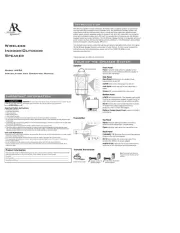
14 Juli 2025
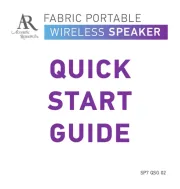
14 Juli 2025
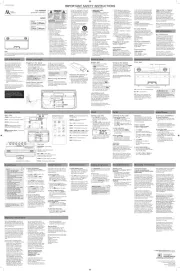
14 Juli 2025
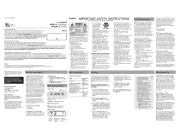
11 Juli 2025
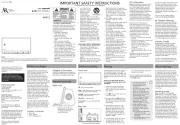
11 Juli 2025
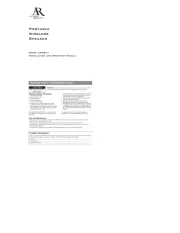
11 Juli 2025
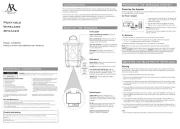
11 Juli 2025
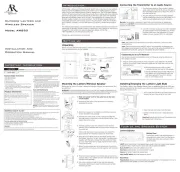
10 Juli 2025
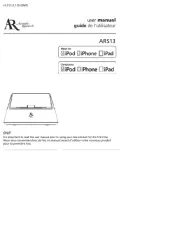
10 Juli 2025
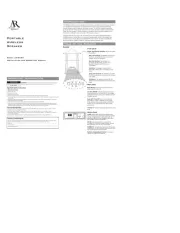
10 Juli 2025
Bedienungsanleitung Lautsprecher
- TFA
- MUZEN
- FoneStar
- Sonus Faber
- HP
- Grandstream
- Adj
- Audizio
- Thomann
- HEOS
- Targus
- Braun
- DigiTech
- Visaton
- Montarbo
Neueste Bedienungsanleitung für -Kategorien-

14 Juli 2025
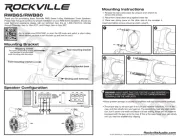
14 Juli 2025
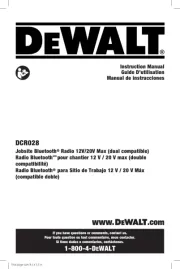
14 Juli 2025
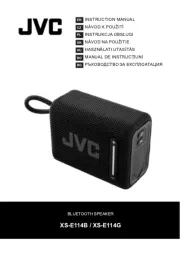
14 Juli 2025
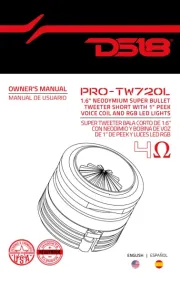
14 Juli 2025
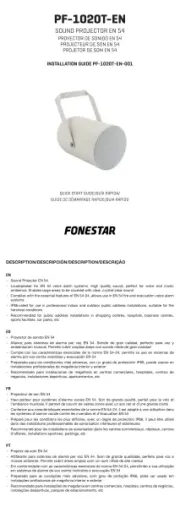
14 Juli 2025

14 Juli 2025

14 Juli 2025
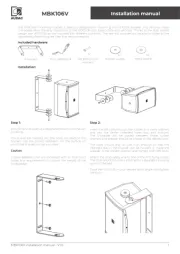
14 Juli 2025
